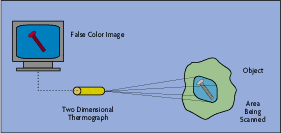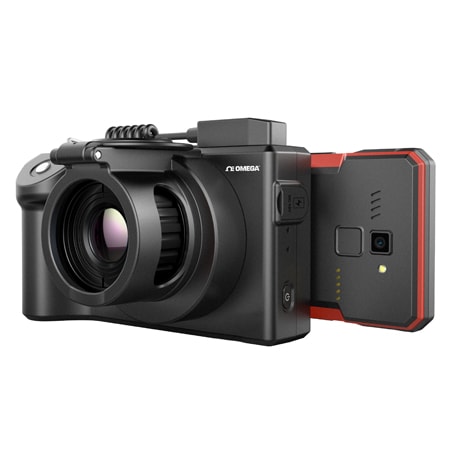Thermography extends the concept of point radiation thermometry to one-dimensional profiles or two-dimensional pictures of non-contact temperature data.
Thermal cameras find use in the maintenance function in manufacturing plants, especially in the asset-driven capital intensive industries in which temperature is an active concern and diagnostic tool. Typical targets for infrared inspection include electrical equipment, frictional effects of power transmission equipment, and thermal processing steps in a production line.
2-D Thermographic Analysis
Two-dimensional figures are planes exhibiting only length and width but no height. The two-dimensional plane in question is the view you see with your own eyes. The thermographic equipment in question is an infrared camera comparable in size to a video camera.

Whereas a standard video camera responds to visible light radiating from the object in view, thermographic units responds to the object's infrared radiation. The scene through the camera's viewfinder is presented in false colors designed to convey temperature information.
Specular surfaces, especially metallic ones, reflect infrared radiation. The image of a shiny metal surface viewed through an infrared camera contains thermal information inherent to and radiated by the surface as well as thermal information about the surroundings reflected by the surface.
When monitoring the temperature of a transparent object, the optical system may pick up a third source of radiation that transmitted through from objects on the other side. Modern imagers have emissivity controls that adjust the response of the unit so that it reads accurately.
The compact size of thermographic imagers eliminates the need for tripods and other factors that limit mobility. In fact, in an industrial setting, the technician using the hand-held imager may well be reading temperatures or capturing images while walking around.
Applications of Thermography
 Handheld Thermal Imager with Smartphone integration
Handheld Thermal Imager with Smartphone integration
An effective predictive maintenance program implies the need to collect sometimes rather sophisticated data from productive assets located around the plant floor. A plant maintenance technician normally follows a predetermined route and visiting plant assets in a specific sequence. This makes data collection as efficient as possible. At each asset, the technician collects data from discrete sensors while working from a check list so as not to miss a reading. In the case of thermography, the data consists of one or more images of the relevant machine parts. For this reason, using thermal cameras for these applications is common within different industries.
The technician using the imager in the field must be aware of reflections of irrelevant heat sources that appear to be coming from the object being scanned. Physically moving the imager to the left or right could make a dramatic difference in the apparent temperature of the object. The difference is caused by the reflections of shop floor lighting fixtures, sunlight through windows, and other extraneous sources.
After the thermographic data collection is complete, the technician or the data analyst evaluates the images for evidence of thermal anomalies that indicates a need for either scheduled or immediate repair.


